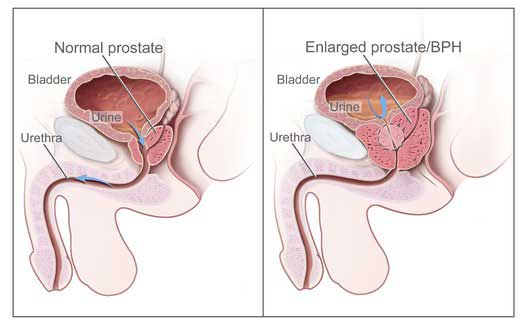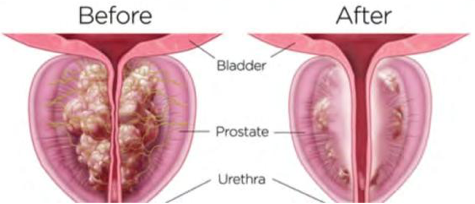Rezum Procedure BPH
The Urinary System
The urinary system begins with the kidneys, which make urine that runs through tubes down to the bladder. The bladder’s job is to store urine until full, then empty to the outside through the urethra, which is the pathway to the outside.
The prostate is the first part of the pathway. When men are 20, the pathway is wide open. When men reach the age of 40, the pathway begins to get blocked as the prostate enlarges.

The prostate enlarges in most men (known as benign prostatic hyperplasia, or BPH). If the enlarged prostate is not causing symptoms, it can be left as is. If the prostate enlarges and “blocks the road”, causing urinary bother, then an effort can be made to help lessen the burden associated with the change in urination.
When deciding what type of treatment should be used to help lessen the bother associated with the urinary changes, it is useful to look at the benefits and burdens of each of the different treatment avenues.
Pills are often used as the first choice. In broad terms, there are two types of medication. The first type, the alpha blockers, open the road by relaxing the outer grip of the prostate. The second type, Proscar and Avodart, reduce the size of the enlargement, and can lead to less blockage after a period, usually 6 to 12 months.
For some men, medications do not provide enough relief. For other men, they do not like having to take pills on an ongoing basis.
If medications are not the answer, there are different techniques available to open the blocked pathway. The most commonly used techniques, greenlight laser and TURP, are very effective ways to open the pathway to relieve the obstruction. These procedures require a general anesthetic, and a catheter that stays in for 2 to 3 days after the procedure. Both of those procedures can cause retrograde ejaculation, also known as dry climax. In that circumstance, semen is still produced, but at the time of climax, it back washes up into the bladder, rather than coming out the tip of the penis with ejaculation.
The Rezum Procedure
New techniques seek to provide a less invasive way to open the blocked pathway. The goals remain the same – remove the blocking part of the prostate, open the urinary pathway, and allow improved urinary flow.
The rezum procedure uses sterile water vapor (steam) that is injected into the enlarged portions of the prostate. The steam causes the prostate cells that are responsible for the enlargement to die, which then leads to shrinking of the prostate, which in turn creates a more open urinary pathway.

The rezum procedure can be done with mild sedation (like sedation used for a colonoscopy) and does not require a general anesthesia. The treatment time is only 10 to 15 minutes.
Postoperatively, a catheter is in place (a tube in the penis to drain the urine) for two or three days after the procedure. Men can resume their normal activities following the procedure.
Postoperative Period
During the initial postoperative period, there can be an increased urinary bother including increased frequency and urgency of urination (got to go and got to get there), pain with urination and perhaps blood in the urine. As the treated area shrinks over time, patients notice the improvement.
Most patients experience symptom relief within several weeks after treatment, and most have noticed further improvement within 2 to 3 months. If symptoms recur in the future, the treatment can be repeated.
One of the main advantages of the rezum procedure is that in most men it does not interfere with erection or ejaculation.
Again, a useful format to understand the approach to the enlarged prostate, is to be aware of the different tools which are available to help, and to view those tools in the context of potential benefits and burdens.
The ideal outcome is to find the treatment avenue that offers the most benefit while minimizing potential burdens.
Dr. Tran (BPH & The Role of Minimally Invasive Treatments)
Contact us to request an appointment or ask a question. We're here for you.



